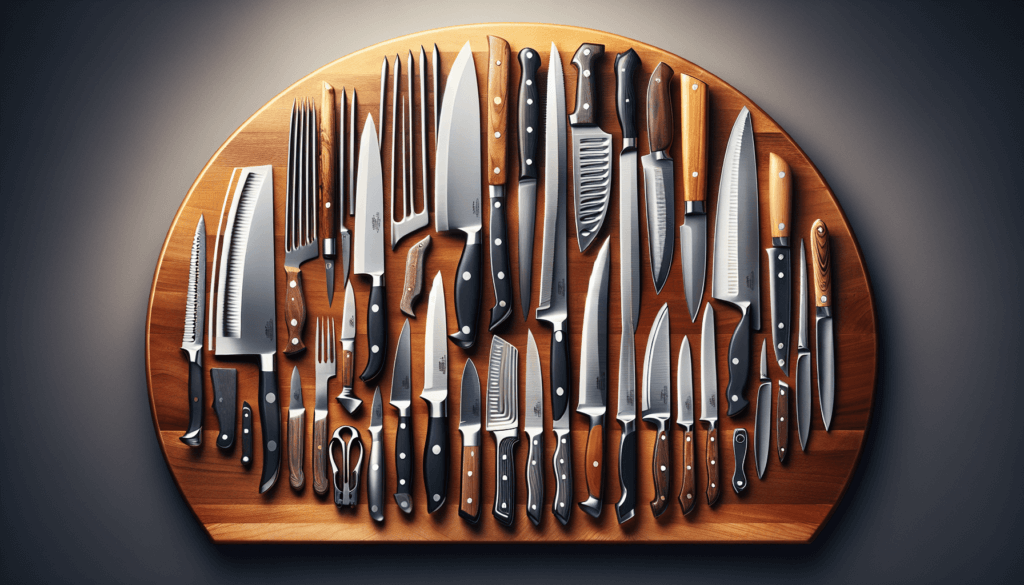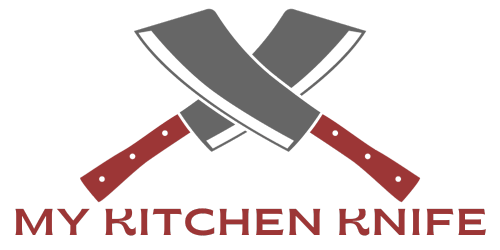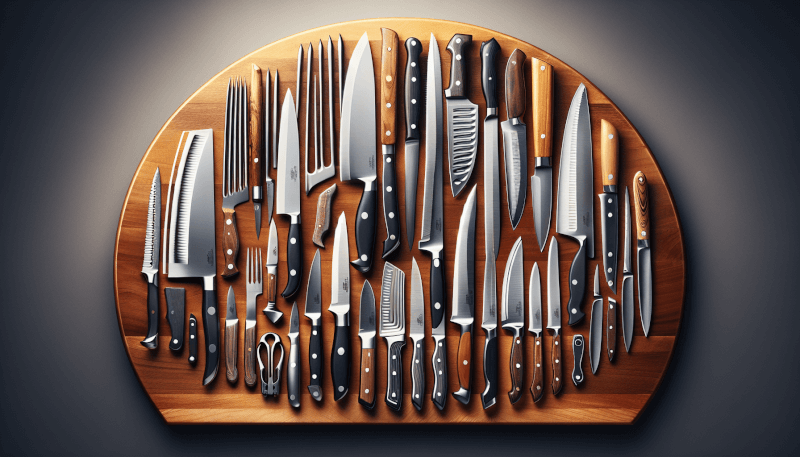Are you tired of struggling with dull and inefficient kitchen knives? Look no further, because we have the ultimate solution for you! In this article, we will provide you with a comprehensive buying guide that will help you make the right choice when it comes to purchasing the perfect kitchen knife. From understanding the different types of knives to learning how to avoid common pitfalls, we have got you covered. Say goodbye to frustrating chopping and slicing experiences, and say hello to a new level of kitchen efficiency and precision. So, let’s dive in and discover what you should be looking for and what to avoid when it comes to choosing the ultimate kitchen knife.
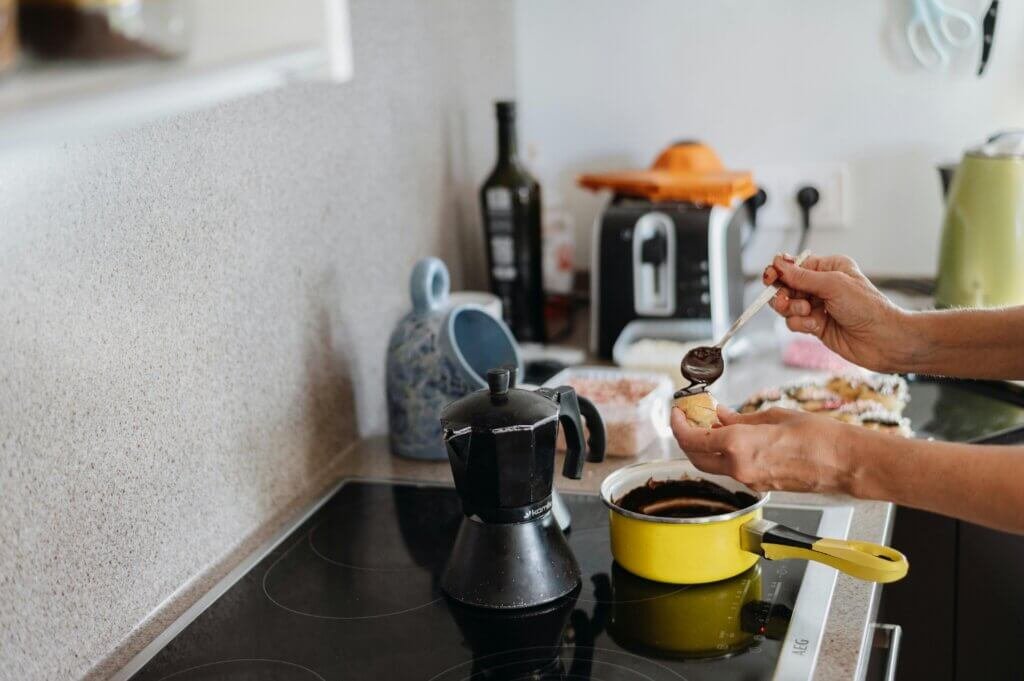
Types of Kitchen Knives
Chef’s Knife
One of the most versatile knives in the kitchen, the chef’s knife is a must-have for any home cook or professional chef. With a broad and curved blade that tapers to a sharp point, it is perfect for chopping, slicing, and dicing fruits, vegetables, and meats. The length of a chef’s knife typically ranges from 6 to 12 inches, but the most common size is 8 inches. This knife offers excellent control and balance, making it a go-to tool for various kitchen tasks.
Serrated Knife
If you enjoy slicing through crusty bread or delicate tomatoes without crushing them, a serrated knife is a necessity. Its unique saw-like edge enables smooth and precise cuts through tough or soft surfaces with minimal pressure. With varying lengths available, ranging from 6 to 10 inches, you can choose the size that best suits your needs. Additionally, a serrated knife comes in handy for slicing cakes, pastries, and citrus fruits, making it a versatile addition to any kitchen.
Paring Knife
When it comes to precision tasks like peeling, trimming, and intricate cutting, a paring knife is your go-to tool. With a narrow and pointed blade measuring around 3 to 4 inches, it offers unmatched control and maneuverability. This knife can easily handle delicate tasks such as deveining shrimp, removing seeds from fruits, or creating decorative garnishes. Its small size also makes it ideal for tasks that require intricate movements, such as trimming fat from meat or hulling strawberries.
Bread Knife
If you enjoy a fresh loaf of crusty bread, a bread knife is essential for achieving perfect slices. The long, serrated blade of a bread knife effortlessly cuts through thick crusts, ensuring clean and even slices without squishing the delicate crumb inside. Available in lengths ranging from 8 to 10 inches, you can find a size that suits your bread slicing needs. Additionally, a bread knife can handle slicing through cakes and pastries with ease, making it a versatile tool for any baker.
Utility Knife
A utility knife is a jack-of-all-trades in the kitchen, suitable for a variety of tasks that don’t require the precision of a paring knife or the length of a chef’s knife. With a blade length typically ranging from 4 to 7 inches, a utility knife is perfect for small, quick cutting tasks such as slicing small fruits and vegetables, peeling, and trimming. Its compact size and versatility make it a handy knife for everyday use in the kitchen.
Santoku Knife
Originating from Japan, the Santoku knife has gained popularity worldwide for its versatility and functionality. With a wider and shorter blade compared to a traditional chef’s knife, the Santoku knife excels at slicing, dicing, and mincing tasks. It features a unique hollow edge or Granton edge design, which minimizes food sticking to the blade. The Santoku knife typically has a blade length of around 7 inches, making it a fantastic tool for both professional chefs and home cooks alike.
Carving Knife
When it’s time to slice up that perfectly roasted meat or turkey, a carving knife is your best companion. With a long and slender blade that typically ranges from 8 to 14 inches, it ensures smooth and even slices with minimal effort. The pointed tip of a carving knife allows for easy maneuvering around bones and joints, making it ideal for precision cuts. Whether you’re serving a holiday feast or hosting a dinner party, a carving knife is a must-have for creating impressive presentation and perfectly portioned slices.
Cleaver
Known for its robust and heavy-duty nature, a cleaver is primarily used for heavy-duty tasks such as cutting through bones, joints, and hard vegetables. With its thick and wide blade, a cleaver can handle tough cutting tasks that other knives may struggle with. The weight of the cleaver provides much-needed power and leverage, making it a preferred tool in professional kitchens and for those who frequently work with large cuts of meat or tough ingredients.
Blade Materials
Stainless Steel
Stainless steel is the most common blade material used in kitchen knives due to its durability, resistance to rust and corrosion, and ease of maintenance. It is a versatile material that retains sharpness well and is relatively affordable. However, not all stainless steel is created equal, as different grades and compositions can affect the knife’s performance and longevity.
Carbon Steel
Traditionally used for knives, carbon steel offers superior sharpness and edge retention compared to stainless steel. It is known for its ability to develop a patina over time, which enhances its performance and protects against rust. However, carbon steel requires more maintenance and care to prevent corrosion, as it is prone to staining and can react with acidic foods. Additionally, carbon steel blades may need more frequent sharpening to maintain their optimal cutting performance.
Ceramic
Ceramic blades are known for their exceptional sharpness and edge retention, making them ideal for precise and delicate cutting tasks. They are also lightweight and resistant to rust and corrosion. However, ceramic knives are brittle and susceptible to chipping or breaking if mishandled or dropped onto a hard surface. They require specialized sharpening equipment or professional services to ensure proper maintenance, which may add to the overall cost.
High-Carbon Stainless Steel
Combining the best of both stainless steel and carbon steel, high-carbon stainless steel blades offer the durability and stain resistance of stainless steel with the superior sharpness and edge retention of carbon steel. These blades are designed to deliver excellent cutting performance while minimizing maintenance requirements. High-carbon stainless steel is a popular choice for those seeking a balance between performance and convenience.
Damascus Steel
Damascus steel blades are known for their striking and unique patterns, created by layering multiple types of steel together. This traditional and artisanal approach results in blades with exceptional strength, durability, and sharpness. Damascus steel knives are highly prized for their beauty and performance. However, they can be harder to maintain and may require specialized care, making them more suitable for experienced users or collectors.
Blade Length
8 Inches
An 8-inch blade length is the most common and versatile choice for a chef’s knife. It offers a perfect balance between maneuverability and cutting capacity, making it suitable for a wide range of kitchen tasks. Whether you are chopping vegetables, slicing meat, or mincing herbs, an 8-inch chef’s knife can handle it all with ease. If you’re unsure which size to choose, an 8-inch chef’s knife is an excellent starting point for most cooks.
6 Inches
A 6-inch blade length is a compact and nimble option for those who prefer smaller knives or have limited space in their kitchen. While it may not offer the same cutting capacity as its larger counterparts, a 6-inch chef’s knife is still versatile enough to handle most everyday tasks. It excels at precision work, such as peeling, trimming, and slicing small fruits and vegetables. Additionally, its smaller size is ideal for those with smaller hands or those who prefer a lighter knife.
10 Inches
If you frequently work with larger ingredients or need to tackle hefty cuts of meat, a 10-inch chef’s knife is worth considering. The extra length provides greater cutting capacity and allows for more efficient slicing and chopping. However, it is important to note that a longer blade requires more control and may be unwieldy for those with smaller hands or less experience in the kitchen.
4 Inches
A 4-inch blade length is ideal for tasks that require precision and intricate cutting. Paring knives with a 4-inch blade are perfect for peeling, deveining shrimp, and other delicate tasks that demand maneuverability and control. Additionally, a small paring knife is a practical tool for tasks such as hulling strawberries or creating decorative garnishes. Its compact size makes it easy to handle and store, making it a valuable addition to any kitchen arsenal.
Handle Materials
Wood
Wooden handles are known for their timeless and natural appeal. They provide a warm and comfortable grip, making them a popular choice for many chefs and home cooks. Wood handles can vary in type and quality, with common options including hardwoods like walnut, birch, and olive wood. However, it is important to note that wood handles require more maintenance and care to prevent cracking or warping. Regular oiling and keeping them away from excessive moisture are essential to prolong their lifespan.
Plastic
Plastic handles offer practicality and affordability, making them a common choice for everyday kitchen knives. They are lightweight, easy to clean, and typically dishwasher safe. Plastic handles may come in a variety of styles and colors, allowing for customization and personal expression. While they may lack the premium feel of other handle materials, plastic handles are a practical option for those seeking a cost-effective and low-maintenance choice.
Stainless Steel
Stainless steel handles are known for their durability and sleek appearance. They provide a sturdy and balanced grip, catering to those who prefer a heavier knife. Stainless steel handles are often found in professional-grade knives due to their resistance to corrosion and their ability to withstand heavy use. However, they can become slippery when wet, so it is important to consider the texture or grip design on the handle to ensure a secure hold.
Composite
Composite handles are made by combining different materials, such as wood, plastic, or stainless steel, to create a unique and customizable handle. These handles offer the benefits of each material used, resulting in a well-balanced grip that is comfortable and durable. Composite handles can provide a personalized touch to your knife while offering the qualities of multiple materials in one handle. They are often found in high-end knives and are favored by professional chefs.
Rubber
Rubber handles are designed to provide a secure and slip-resistant grip, even in wet or greasy conditions. They are comfortable to hold and reduce the risk of accidents caused by a slippery handle. Rubber handles are commonly used in fillet knives or knives intended for outdoor activities, where a strong grip is essential. However, it is important to note that rubber handles may require more frequent cleaning and maintenance to prevent bacterial growth or odors.

Handle Design
Full Tang
Full tang handles are considered to be the most robust and durable handle design. In full tang construction, the blade extends through the entire length of the handle, providing maximum strength and stability. This design ensures a well-balanced knife and minimizes the risk of the blade detaching from the handle during heavy use. Full tang handles are often preferred by professional chefs and those seeking knives of exceptional strength and longevity.
Rivet Design
Rivet design handles are constructed by securing the handle scales to the tang of the blade with metal rivets. This method provides a secure and stable handle that can withstand regular use and heavy cutting tasks. The number of rivets used may vary depending on the knife’s size and design. Rivet design handles offer a classic and timeless aesthetic, making them a popular choice for both professional and home cooks.
Ergonomic Grip
An ergonomic grip handle is designed to provide maximum comfort and reduce hand fatigue during extended use. These handles are contoured to fit the natural shape of the hand, offering a secure and comfortable grip. Ergonomic handles may feature finger grooves or textured grips to further enhance control and minimize the risk of slippage. Their design makes them suitable for those who spend long hours in the kitchen or have conditions that affect hand strength or flexibility.
Textured Handle
Textured handles feature a surface with raised patterns, ridges, or indentations to improve grip and prevent slippage. These handles are ideal for those who require a secure hold, particularly when working in wet or greasy conditions. Textured handles can come in various forms, such as dimples, ridges, or bumps, offering different levels of grip for individual preferences. They provide an added level of control and safety, making them a popular choice in professional kitchens or for those who prioritize safety during food preparation.
Bolster
A bolster is a thick metal collar located between the blade and the handle. It serves multiple purposes, including providing balance, stability, and protection for the hand during cutting tasks. Bolsters are often found in high-quality knives and are indicative of superior craftsmanship. They can enhance the overall balance of the knife, making it easier to maneuver and control. Additionally, bolsters can act as a finger guard, preventing accidental slippage while maintaining a secure grip.
Knife Balance
Handle-Heavy
A knife with a handle-heavy balance means that more weight is concentrated toward the handle. This balance is suitable for those who prefer a knife that feels substantial in their hand and provides additional control during cutting tasks. A handle-heavy knife can help reduce hand fatigue and offers stability during prolonged use. Chefs who prefer a rocking motion for chopping or prefer larger knives may find handle-heavy knives to be more comfortable.
Blade-Heavy
Blade-heavy knives have more weight toward the blade end, making them ideal for tasks that require more force or leverage, such as splitting or cleaving. The extra weight near the blade provides momentum and power, enabling efficient cutting through tough ingredients or bones. However, a blade-heavy knife may require more control and technique to avoid accidentally tipping or applying excessive force.
Neutral Balance
A knife with a neutral balance provides an even distribution of weight between the handle and the blade. This balance offers versatility and adaptability, making it suitable for a wide range of cutting tasks. A neutral balance allows for effortless control and maneuverability, accommodating various cutting techniques and preferences. Whether you prefer a pinch grip or a full grip, a knife with a neutral balance provides a comfortable and balanced cutting experience.

Maintenance and Care
Sharpening
Regular sharpening is essential to maintain the optimal cutting performance of your kitchen knives. Depending on the blade material and frequency of use, you may need to sharpen your knives every few months or once a year. You can sharpen your knives using a sharpening stone, honing rod, or a professional sharpening service. It’s crucial to follow the correct technique and ensure proper angle control during sharpening to maintain the knife’s edge and prolong its lifespan.
Honing
Honing should be done regularly to maintain the sharpness and alignment of the knife’s edge. Contrary to popular belief, honing does not sharpen the blade but rather straightens and realigns the edge. Using a honing rod, gently run the blade along the rod at a 15–20-degree angle, ensuring even pressure on both sides of the blade. Honing before each use will help keep your knife’s edge in optimal working condition between sharpenings.
Handwashing vs Dishwasher
To ensure the longevity of your kitchen knives, handwashing is highly recommended. Dishwashers can cause damage to the blade and handle, such as dulling the cutting edge, loosening the handle, or causing corrosion. Handwashing allows for gentle cleaning, preventing any unnecessary wear or damage. Use mild dish soap and warm water, gently scrub the blade with a soft sponge or brush, and thoroughly dry the knife before storing it.
Storage
Proper storage is crucial to prevent damage to your kitchen knives and ensure their longevity. We recommend storing knives in a knife block, knife drawer inserts, magnetic knife strips, or knife rolls. These storage options provide protection by keeping the blades safely separated and avoiding contact with other utensils. Always ensure the blades are dry before storing to prevent moisture-related issues such as rust. Never store knives loose in a drawer, as this can result in damage to both the blade and yourself.
Cost and Budget
Entry-Level Knives
Entry-level knives are often more affordable and suitable for those who are just starting to build their kitchen knife collection. While they may not offer the same level of craftsmanship and performance as higher-priced options, entry-level knives can still deliver reliable cutting performance for everyday kitchen tasks. These knives often feature stainless steel blades with basic handle materials, serving as a cost-effective option for those on a budget.
Mid-Range Knives
Mid-range knives strike a balance between price, quality, and performance. These knives often boast better blade materials, such as high-carbon stainless steel, and more sophisticated handle designs. They are suitable for those who want a step up in quality without breaking the bank. Mid-range knives offer excellent cutting performance, durability, and aesthetics, making them a popular choice for both home cooks and professionals.
High-End Knives
High-end knives are the pinnacle of quality, craftsmanship, and performance. These knives often incorporate premium blade materials, such as Damascus steel or high-end stainless steel alloys, resulting in exceptional sharpness, edge retention, and beauty. The handles of high-end knives are typically made from high-quality materials crafted with precision and attention to detail. While high-end knives come with a higher price tag, they are investments that can last a lifetime for those who seek the utmost in cutting performance and aesthetics.
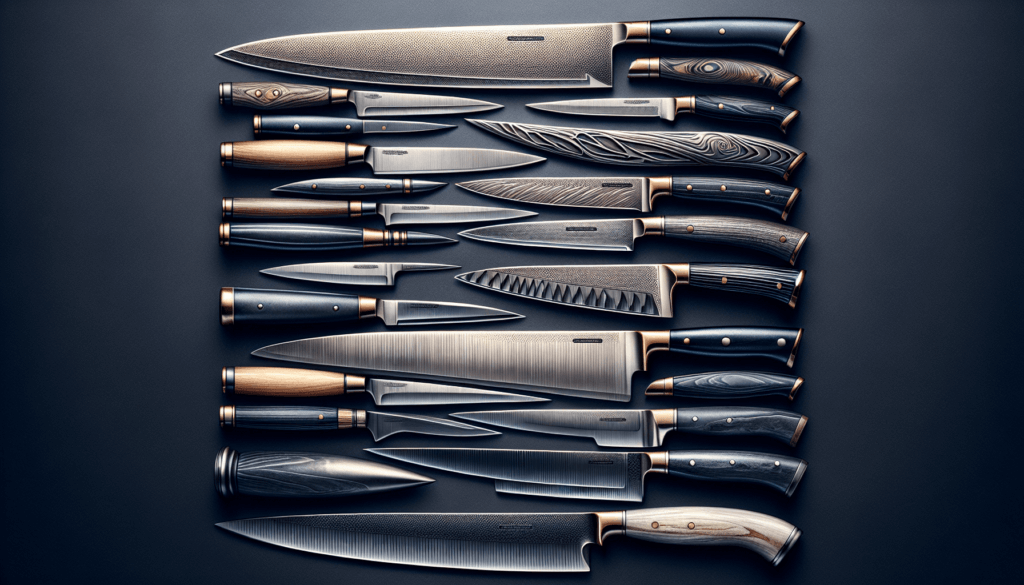
Brand Reputation
Researching Brands
When it comes to purchasing kitchen knives, researching different brands is essential. Look for well-established brands that have a reputation for producing high-quality knives with excellent craftsmanship. The brand’s history, expertise, and commitment to quality are important factors to consider. Researching brands gives you insights into their manufacturing process, materials used, and the overall reputation they hold in the culinary world.
Customer Reviews
Reading customer reviews can provide valuable insights into the performance and durability of a particular knife or brand. Pay attention to the overall satisfaction rating, as well as individual experiences and comments regarding the knife’s sharpness, ease of use, and longevity. Customer reviews also offer insights into a brand’s customer service and support, which is crucial in case of any issues or concerns with the product.
Warranty and Customer Support
A reputable brand will often offer warranty coverage and excellent customer support. Look for brands that stand behind their products with warranty policies that cover manufacturing defects or faults. A warranty provides peace of mind, knowing that the manufacturer stands by the quality and craftsmanship of their knives. Additionally, responsive and helpful customer support can assist in addressing any concerns or questions you may have about your purchase.
Avoiding Common Mistakes
Buying Knife Sets with Unnecessary Knives
When shopping for kitchen knives, it can be tempting to opt for a knife set that includes a wide variety of knives. However, many knife sets often include knives that are rarely used in everyday cooking. Instead, focus on investing in a few essential knives tailored to your cooking preferences. This way, you can ensure that you have the right tools for the tasks you commonly perform in the kitchen, without cluttering your countertop or overspending on unnecessary knives.
Neglecting Comfort and Grip
Comfort and grip are crucial considerations when choosing kitchen knives, as they directly impact your cutting experience and safety. Handle materials and designs can greatly affect the knife’s ergonomics and how it feels in your hand. Consider factors such as handle shape, size, and texture to ensure a comfortable grip that suits your hand size and cutting style. Neglecting comfort and grip can lead to hand fatigue, reduced control, and potentially accidents in the kitchen.
Overlooking Maintenance Requirements
Proper maintenance and care are essential for maximizing the lifespan and performance of your kitchen knives. Neglecting regular sharpening, honing, or improper cleaning techniques can significantly impact the blade’s sharpness, edge retention, and overall durability. Before purchasing a knife, assess whether you are willing to commit to the maintenance requirements it may entail. Some blade materials, such as carbon steel or ceramic, require extra care and specialized maintenance compared to stainless steel blades.
Not Considering Kitchen Tasks
Consider your specific cooking needs and the tasks you commonly perform in the kitchen when selecting knives. If you primarily work with fruits and vegetables, investing in a reliable chef’s knife and paring knife would be beneficial. If you frequently handle large cuts of meat, a carving knife or cleaver may be more suitable. Choosing knives based on your individual kitchen tasks ensures that you have the right tools for efficient and enjoyable cooking experiences.
In conclusion, selecting the right kitchen knife is a personal journey that requires careful consideration of various factors. Understanding the different types of kitchen knives, blade materials, blade lengths, handle materials, handle designs, balance, maintenance and care requirements, cost, brand reputation, and common mistakes to avoid will guide you towards making an informed decision. Remember, investing in high-quality knives that suit your preferences and cooking needs can greatly enhance your culinary experiences and make your time in the kitchen more enjoyable.
